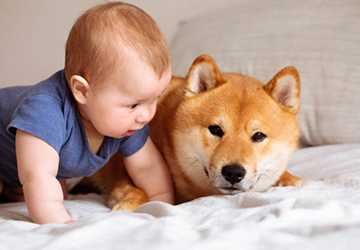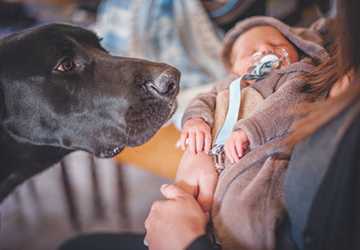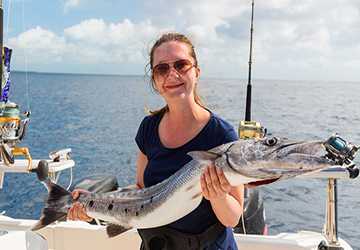How to Introduce Pets to Your Newborn: Safety First
Welcoming a new family member is an incredibly joyful event, but it also brings challenges and adjustments. Of these adjustments, many new parents are most concerned about introducing their beloved pet to their newborn baby. Ensuring a safe and harmonious coexistence between your furry friends and the smallest members of your family is crucial. This article will guide you in introducing pets to your newborn, with safety as your top priority.

1. Preparation is key
Before your baby is born, it's essential to prepare your pet for the changes ahead. If you haven't already, start by establishing a consistent routine for your pet. This will help them get used to sharing your attention and space. Gradually reduce the amount of attention and physical contact they receive from you, and prepare for the inevitable reduction in their one-on-one time.
Another critical aspect of preparation is ensuring your pet is up to date on vaccinations and parasite control. Not only does this protect your baby, but it also ensures your pet stays healthy. It's best to consult with your veterinarian to ensure your pet is in top condition.
2. Step by step introduction
Once your baby comes home, resist the urge to introduce them suddenly. Instead, choose a gradual and controlled process. Remember, pets are creatures of habit and may be frightened by sudden environmental changes. First, let your pet explore the new smells and sounds that come with the birth of a baby. They will be curious, and it is essential to satisfy that curiosity.
You can bring a piece of baby clothing home from the hospital to help your pet get used to your baby's smell. This simple process can go a long way in preparing your pet for introductions.
3. Encounters under supervision
Be sure to supervise your pet and your newborn when they meet face-to-face for the first time. Start with brief, controlled interactions. Keep pets on a leash or in a crate so they can see your baby from a distance. Maintain a calm, positive atmosphere. Offering your pet a treat or praise during the first meeting can build a positive bond.
If your pet shows signs of distress, such as growling or hissing, it's important not to scold them. Instead, gently distract your dog and seek the advice of a professional dog trainer if necessary.
4. Stay regular
Maintaining your pet's daily routine as much as possible is essential for their health and to help them adjust to the changes that come with a new baby. Pets thrive on predictability. So, try to feed them, walk them, and give them attention before the baby is born. This consistency can ease their fears and minimize any resentment or jealousy.
If you have a dog, make sure to meet their exercise needs. Tired dogs are generally well-behaved and less anxious. Regular exercise can help prevent behavioural problems and ensure your dog has fewer problems.
5. Set boundaries
To ensure safety and harmony in your home, it's essential to set clear boundaries with your pets. For example, if you decide to keep pets out of a child's room, follow this rule. Baby gates and closed doors can help maintain these boundaries.
Teaching your pet basic obedience commands such as "sit," "stay," and "go" can be very useful in ensuring that his behaviour with babies is controlled. By consistently following these orders, you will strengthen your authority and provide a safe environment.

6. Monitor body language
During the introduction, it is crucial to understand your pet's body language. Pets communicate primarily through body language. If you can interpret their signals, you can predict and prevent unwanted reactions.
Look for signs of fear in your dog, such as lowered ears, tucked tail, or nervous posture. When cats feel upset, they may flatten their ears, hiss, or arch their backs. It's essential to treat these signs promptly to prevent problems from arising.
7. Health and Safety Measures
Maintaining a clean and hygienic home environment is vital to your baby's safety. Pets sometimes carry dirt and allergens. Therefore, be diligent about caring for and cleaning your pet regularly. Also, wash your hands after handling pets, especially before tending to your baby's needs.
To further increase safety, store pet food and trash securely, as curious toddlers may try to explore these areas. Invest in a quality baby gate to protect your baby from pet food and litter boxes.
8. Never leave pets and newborns unattended
This golden rule cannot be overstated, as it is vital to your baby's safety. Even if your pet shows nothing but affection and tenderness, you must respect the unpredictability of animals and the innate curiosity of babies. In an instant, a pet's innocent behaviour can inadvertently harm a baby.
Therefore, unwavering vigilance must be maintained. No matter how busy life gets, always value the presence of a responsible adult when your pet and newborn are together. In the delicate balance of pets and babies living together, this simple but essential guideline is non-negotiable.
9. Consider professional help if needed
In some cases, despite your diligent efforts and commitment to a smooth transition, your pet may exhibit persistent anxiety or behavioural issues around a newborn. These challenges can be complex and emotionally stressful for you and your pet. In this situation, it is essential to recognize that professional intervention is a valuable resource.
Certified animal behaviourists and experienced trainers have the expertise to assess unique dynamics and provide strategies tailored to your situation. Your advice may be the key to building a safe, harmonious, and lasting relationship between your pet and your precious new family member.
10. Gradual socialization
Gradual socialization is a crucial stage in integrating your pet with your newborn. As your child grows, it's essential to nurture the relationship between him and his furry companion. Encourage gentle interaction and foster a sense of trust and companionship. Teach your child to respect your pet's boundaries and signals, such as when he needs space or wants to play.
Over time, these interactions can transform into endearing and loving connections that benefit a child's development by instilling empathy and responsibility. This gradual socialization process not only strengthens the emotional bond between your pet and child but also ensures a safe, loving, and enriching environment for your entire family.
Diploma
Introducing a pet to a newborn is a process that requires patience, preparation, and a keen eye for safety. Your pets are an integral part of your family, and with the right approach, they can get along well with your new baby. Remember, the safety and well-being of your pets and children should always be your top priority. With proper preparation, supervision, and guidance, your four-legged friend and your child can develop a loving, lifelong bond.




















